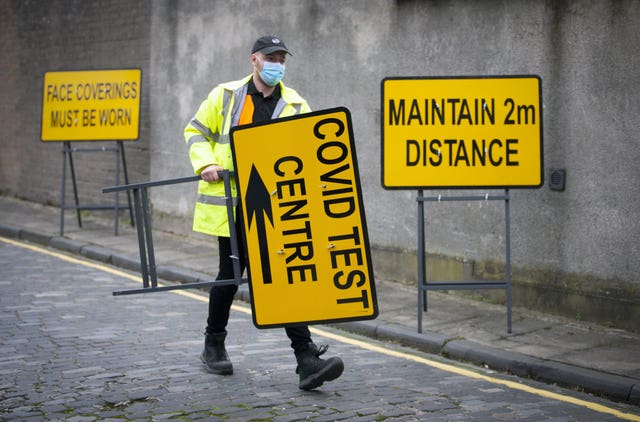Mass testing using rapid tests has the potential to have a “large effect” on Covid-19 transmission in the UK, experts have said.
A new study examined the effect of mass testing for Covid-19 on the population of Slovakia during a lockdown.
Researchers from the London School of Hygiene and Tropical Medicine examined transmission rates in the European country after mass
testing was introduced for the whole population during a week-long lockdown.
A combination of mass testing, the lockdown, and a 10-day quarantine for people who tested positive along with those they lived with, led to a reduction in transmission in the country of around 60%.
The researchers said that their findings show that mass testing has the potential to reduce the length of any future lockdowns and help break the chains of transmission of the virus.
But they cautioned that the findings were difficult to translate to other countries because they could relate to very specific measures introduced by Slovakia.

For instance, in Slovakia, those who tested negative had to show their test result to their employer to go back to work and people told to self-isolate received their full salary.
Meanwhile, the authors stressed the tests in Slovakia were being conducted by trained personnel – rather than self-administered, which is how many tests in the UK are conducted – which may have had a big impact.
In October, a one-week lockdown was initiated in the country after a rise in infections, with stay at home orders in place apart from those who could not work at home and primary school-aged schooling.
Mass testing was initially introduced where infection rates were highest, then nationwide.
The test, a 15-minute lateral flow test called SD Biosensor, was offered to everyone aged between 10 and 65 and people were tested by medical personnel.
People who tested positive were urged to self trace their contacts from the last 48 hours before their positive result.
Those who did not participate in mass testing were mandated to undergo 10 days of quarantine – but between 80 and 90% of eligible people attended the mass testing.
And those who tested negative were given a certificate which enabled them to go back to work – but this only lasted a week while the mass testing was done.
The preliminary analysis, which is yet to be peer reviewed, found that the mass testing of Slovakia’s entire population while under lockdown reduced Sars-CoV-2 infections by more than 60% in one week.
The R number in Slovakia was 1.4 before the measures were introduced. Afterwards it fell to 0.6.
The authors of the study estimated the policies picked up around 90% of the people that were infectious at that time.
Dr Stefan Flasche, associate professor at the London School of Hygiene & Tropical Medicine, said: “In Slovakia, we see some strong evidence that the combined intervention of a short-term lockdown with a large-scale mass testing campaign has led to a very rapid reduction in the burden of Covid-19 infections.”
He added: “If it’s done in a right way, mass testing has the potential to have a very large effect. I think that that’s what we learned from Slovakia.”
Dr Sebastian Funk, associate professor and Wellcome Trust senior research fellow at the London School of Hygiene & Tropical Medicine, added there is “huge potential” in the combined interventions.
“This worked in Slovakia,” he added.
“I think it’s important to be aware of context. So for example the high attendance – it is not clear whether that would necessarily translate to the UK.”
He said that the findings suggest that should cases rise again in Britain, a mass testing programme accompanied with a short, sharp lockdown could help stem the rise of infections.

“What we see certainly suggests that,” said Dr Funk.
“[But] there might also be an issue of scale there, in that it is a much smaller country so it is easier for those tests to be available.
“If you want to bring case numbers down, what this seems to have done is to really reduce the time you need to be under lockdown.
“And that is the appealing thing about it.”
When asked about the different tests available, Dr Flasche, added: “My feeling for the moment is that the way you’re taking the swab may make a bigger difference than for the actual test.”
He acknowledged that others have criticised the use of a rapid tests for allowing people to see high-risk individuals, such as testing students to allow them to go home to their parents, or visiting loved ones in care homes.
“In that case a test can give a false security,” he said. “Because the test will not be 100% clear in that tomorrow or the day after you will not potentially infect someone else.
“I think what the test is really good at is helping us identify a large number of infectious people who we wouldn’t otherwise find.
“But it doesn’t mean that if you’re negative you should just go and do whatever you want to do. It just means that while helping us to identify a large number of additional people who are currently infectious, we’re probably getting on top of things in terms of the overall transmission.”




Comments: Our rules
We want our comments to be a lively and valuable part of our community - a place where readers can debate and engage with the most important local issues. The ability to comment on our stories is a privilege, not a right, however, and that privilege may be withdrawn if it is abused or misused.
Please report any comments that break our rules.
Read the rules here